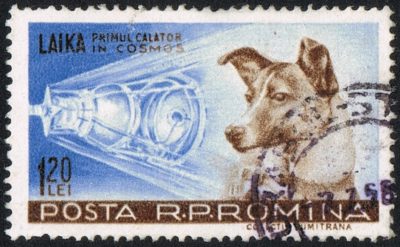by Reinhard Kargl
60 years ago today, topping the spectacular success of Sputnik 1, the Soviet Union again amazed the world with the launch of Sputnik 2. This satellite was much larger than its predecessor, and it carried the first living passenger to space: Laika the dog. The mission paved the way for human spaceflight by proving that life could be sustained in space.
Ever since I was a boy I have been wondering what happened to Laika. My books only reported that she did not survive, but did not give any details. Unfortunately the truth of the matter is rather sad and shocking. I believe Laika’s fate should be mentioned.
At one time, she was a mongrel stray dog wandering the streets of Moscow. She ended up in an animal shelter, and was one of several dogs picked up for the space program. Her age was estimated to be around three years, and she weighed 6 kg (13 pds).
During her training, Soviet personnel called her “Kudryavka” (Russian for “Little Curly”), “Zhuchka” (“Little Bug”) and “Limonchik” (“Little Lemon”), but somehow “Laika” stuck. In addition to her, two alternate dogs were being trained: Albina and Mushka.
The dogs were subjected to noises and forces similar to what they would experience during launch. In order to adapt the dogs to the tiny confines of Sputnik 2, they were kept in progressively smaller containers for up to 20 days. Of course all this meant tremendous stress for the dogs, who stopped urinating and defecating and deteriorated physically. The dogs were trained to eat a gel food, presumably because it produced little bodily waste and was easy to transport and dispense.
The schedule was extremely tight, because Nikita Khrushchev wanted a launch on or before Nov. 7 (the 40th anniversary of the Bolshevik Revolution. It would have been impossible to design a re-entry and landing system in such a short time. As a result, Laika’s flight was planned to end in a fireball. But before re-entry, Laika was meant to be poisoned by remote control.
After the final selection was made, Laika was placed in the satellite three days before launch. Just prior to launch, her fur was sponged in an alcohol solution and iodine was applied. Electrodes were attached to send back telemetry of her bodily functions.
The data showed that during peak acceleration of the launch, her pulse rate increased from 103 to an incredible 240 beats per minute. The poor dog’s breathing quickened to three to four times the normal rate. After engine cut off and in the weightlessness of Sputnik 2’s orbit, she relaxed somewhat, but it took three hours for her life signs to return to normal. She was clearly agitated but appeared to be eating her food.
There had been a problem during launch: one part did not jettison properly, which prevented the climate control system from functioning properly. As a result, the interior of Laika’s vehicle reached 40 °C (104 °F).
Soviet sources gave many conflicting accounts of what happened next, but fact is that Laika suffered a slow and awful death. Perhaps the most authoritative (and most recent) account is contained in a paper submitted by Dr. Dimitri Malshenkov to the World Space Congress in Houston, Texas, in 2002. It asserts that Laika died from overheating between the 5th and 7th hour of the flight.
 Laika has not been forgotten, nor should she be. Her name lives on in numerous books and articles, on postage stamps from various countries, in brands of consumables and in pop music: (iTunes currently lists hundreds of items containing “Laika” in either the artist name or song title).
Laika has not been forgotten, nor should she be. Her name lives on in numerous books and articles, on postage stamps from various countries, in brands of consumables and in pop music: (iTunes currently lists hundreds of items containing “Laika” in either the artist name or song title).





